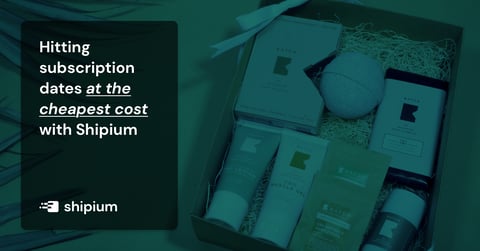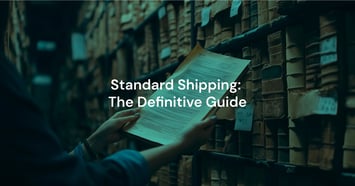Optimize Subscription Delivery with Subscription Timing API

A big portion of ecommerce growth has been the success of subscription business models. From food delivery to pet supplies to haircare, many of the most successful Direct To Consumer companies over the last five years have been subscription products that brought a consistently great product to an eager market.
Speed Accuracy kills
Perhaps more than any other ecommerce business model, delivery accuracy is more important than ever. Sometimes it's about convenience—when someone is expecting their weekly bag of coffee beans, missing the date is a real hassle. Sometimes it's a matter of life and death—medicine delivered a few days too late could have grave consequences.
Hitting those delivery dates is priority number one for subscription-based operators, who work with technical teams to solve that hard constraint.
Fortunately, it's a solvable problem that most have solved by relying on negotiated carrier SLAs and spending the money on those service methods to hit those dates: if the delivery date is February 21, and you use FedEx 2 Day, then schedule the shipment to go out February 19. Easy, right?
The real casualty is margin
But what a drag on cost structures. When doing complementary shipping cost optimization audits for companies interested in Shipium, subscription businesses tend to have the highest cost-per-package (CPP).
The reason why is a simple premise: unlike retail, speed almost always doesn't matter. What matters is hitting a delivery date and working backwards from that, as opposed to using fast service methods with aggressive SLAs. In doing so, technical teams tend to build logic that is, stated simply, [Desired Delivery Date] - [Carrier SLA Days] = [Fulfillment Date]. Too many shipments are unnecessarily shipped at a higher cost than is needed as a result.
There is a fix, though. What we have seen is most subscription-based businesses can easily switch to a model of routing more orders through cheaper service methods with less aggressive SLAs.
For example, if the company knows a desired delivery date for an order, there is no reason they can't rely on their cheapest available service method to hit that date. For subscriptions, SmartPost can service almost all orders 2 Day can as well.
Getting the timing right
The key is making sure that the order is fulfilled and shipped on the right day ahead of the desired delivery date.
Shipping too early could result in an order arriving too soon, causing different problems and poor customer experience. What if it's medicine the customer needs to be home to receive in order to immediately chill?
Shipping too late is even worse. What a poor way to prompt a subscription cancelation.
In a scenario where slower service methods are at play, variability of an actual delivery is higher, making the calculation of when too ship an order harder. This is the central problem for the next level of technical sophistication standing in the way of improved margins. If given 1 million unique shipments, how are you supposed to know the exact right date to fulfill each order to hit the cheapest price?
Enter Shipium's subscription timing API, the tool teams use to get that calculation right and save millions of dollars in shipping.
Flexible APIs to fit your tech stack
The approach is straight forward. Customers ping our API with a set of parameters specific to the future order.
- Destination country
- Postal code of destination address
- Desired delivery date
- Expected origin — interestingly, this can be optional. If you want us to return based on the cheapest across multiple origins, we'll return that, otherwise we'll return the estimate for an origin you specify
- Additional API criteria using features like Ship Option — useful if a particular shipment must use a certain carrier, or to exclude a specific carrier, for example
Shipium then applies the same data science models related to date probabilities as we do for our Delivery Promise estimated delivery dates or Carrier Selection desired delivery date selection criteria. That data model does the following:
- What are all the carriers and service methods eligible for this shipment?
- What has been their historical shipping pattern from ZIP-3 to ZIP-3, ZIP-4 to ZIP-4, ZIP-5 to ZIP-5? This is calculated both with your historical data and all anonymized shipment data across our platform. (Millions of shipments.)
- Layer that in with all the real-time network aspects that the Shipium platform manages for customers, such as weather (or strike!) disruptions, and more.
- For the selected origin, what is the declared order fulfillment duration (e.g. "6 hours") and what are the pick up times for all carrier service methods at that origin?
- Then, which is the cheapest option?
- Finally, combine it all together to compute a suggested date worked back from the desired delivery date.
With the response to the API request being a suggested date, customers like to fit this into the system they build internally to construct their order flow. For example, one customer who uses this API makes a call for all known orders 14 days from "today". With the responses we provide, they then proactively schedule each order to be fulfilled and shipped on that respective date. Your scheme might be different, which is why flexible microservices are essential to your success.
The savings are real
For subscription-based companies who use this API, we have seen cost reduction slightly better than our average.
To recap, the typical average across all customers has been just over 12% parcel cost reduction. For subscription companies, it's closer to 16%.
Cost savings itself isn't necessarily that hard especially with subscription companies. Simply always pick the cheapest option! The challenge is picking the cheapest option and the precise day an order should be fulfilled, and that's where our subscription timing API can help make a difference to the bottom line and customer satisfaction.

Diagonal thinker who enjoys hard problems of any variety. Currently employee #5 and the first business hire at Shipium, a Seattle startup founded by Amazon and Zulily vets to help ecommerce companies modernize their supply chains. Previously was CMO at Datica where I helped healthcare developers use the cloud. Prior to that I came up through product and engineering roles. In total, 18 years of experience leading marketing, product, sales, design, operations, and engineering initiatives within cloud-based technology companies.


